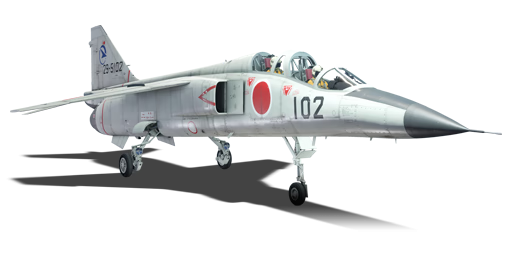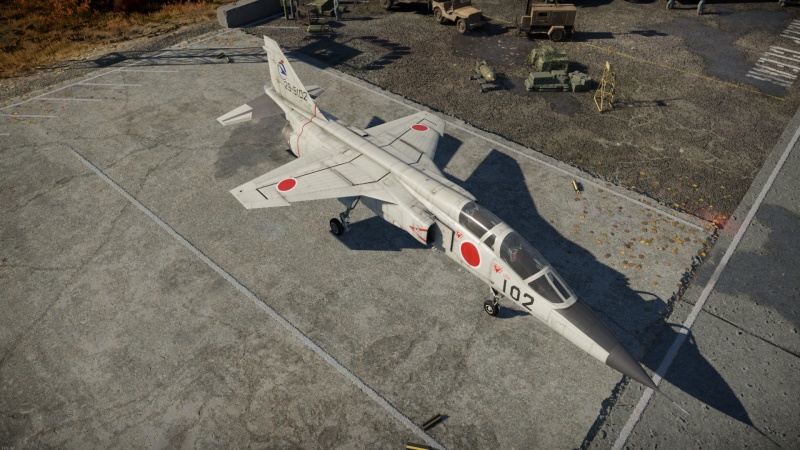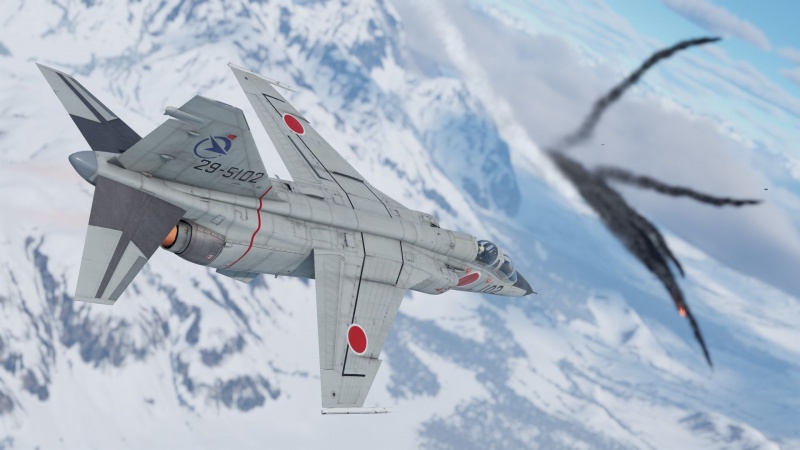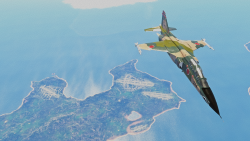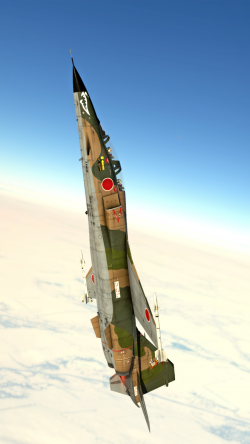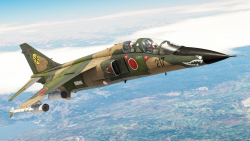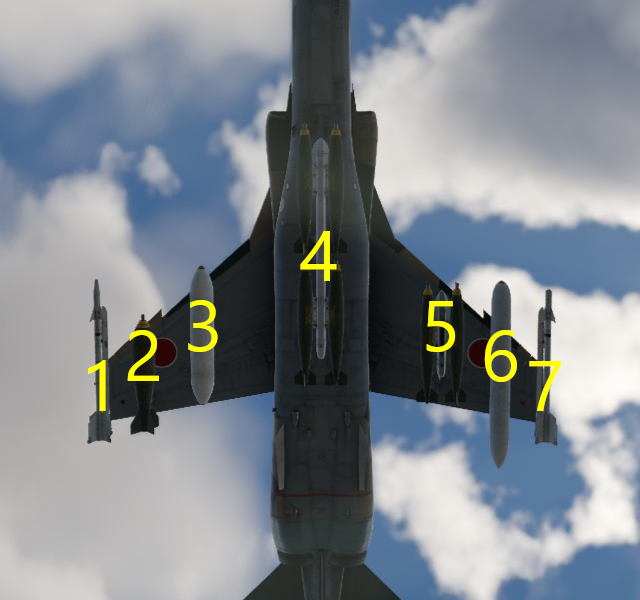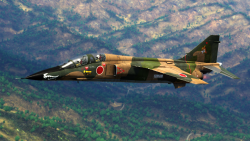Difference between revisions of "T-2 Early"
m (→Pros and cons: Edits) |
hzhang2010 (talk | contribs) m (→Pros and cons) (Tag: Visual edit) |
||
| Line 212: | Line 212: | ||
* Decent PD radar that can detect up to 60 km away, useful in large maps to find targets | * Decent PD radar that can detect up to 60 km away, useful in large maps to find targets | ||
* The high Angle-of-Attack in certain maneuvers can be very useful defensively and offensively | * The high Angle-of-Attack in certain maneuvers can be very useful defensively and offensively | ||
| + | * Very fast in it's BR | ||
'''Cons:''' | '''Cons:''' | ||
| Line 222: | Line 223: | ||
* Mediocre AIM-9E missile | * Mediocre AIM-9E missile | ||
* Both engines overheat at constant use with the afterburner | * Both engines overheat at constant use with the afterburner | ||
| + | * Lacks RWR receiver (however radar missiles are easy to notch at it's BR | ||
== History == | == History == | ||
Revision as of 06:59, 3 July 2023
| This page is about the Japanese jet fighter T-2 Early. For other variants, see F-1 (Family). |
Contents
Description
The Mitsubishi T-2 Early is a premium gift rank VI Japanese jet fighter with a battle rating of 10.0 (AB) and 9.7 (RB/SB). It was introduced in Update "Fire and Ice".
The T-2 Early is a prototype model of the tech-tree T-2 supersonic fighter trainer, and is identical to it in all performance aspects.
General info
Flight performance
The T-2 Early was designed and built for one main purpose, and that was to train pilots in flight at around Mach 1.4 in preparation for flying faster Mach 2+ fighters such as the F-4EJ, F-104, and the Mitsubishi F-1. With a long narrow body, short main wings without fuel tanks and an all-moving tailplane, this aircraft was built streamlined like the F-104 to get you from point A to point B in the shortest amount of time possible and not spend too much time manoeuvring. While excelling as an interceptor, this fighter will still hold its own in a manoeuvring fight, granted as long as under-wing armaments are limited to the Sidewinder missiles and not the heavy bombs.
The sleekness of the aircraft lends itself to flying fast, and speed should be maintained when flying, especially during air-to-air combat, as a slow-flying T-2 Early is a relatively easy target due to poor manoeuvrability at slow speeds. To help in instances where the aircraft must fly at slower speeds (landing, bombing and ground rocket attack), slats and spoilers help create a higher lift capacity and roll rate, preventing the aircraft from stalling and plummeting.
Air-to-air combat should be avoided when carrying bomb loads, as this will significantly decrease manoeuvrability. During a ground attack, all efforts should be made to get to the target as soon as possible and release the heavy ordnance and then proceed to any aerial combat in the near vicinity.
Damage to the aircraft, especially to the wings, will typically result in the destruction of the aircraft. Due to their relatively small size, any loss in surface area will cause the fighter to over-lift on the good side, sending the aircraft into a roll and then potentially into a flat spin.
| Characteristics | Max speed (km/h at 10,975 m) |
Max altitude (metres) |
Turn time (seconds) |
Rate of climb (metres/second) |
Take-off run (metres) | |||
|---|---|---|---|---|---|---|---|---|
| AB | RB | AB | RB | AB | RB | |||
| Stock | 1,679 | 1,664 | 15200 | 33.6 | 34.9 | 119.4 | 109.2 | 900 |
| Upgraded | 1,753 | 1,710 | 32.4 | 33.0 | 162.5 | 140.0 | ||
Details
| Features | |||||
|---|---|---|---|---|---|
| Combat flaps | Take-off flaps | Landing flaps | Air brakes | Arrestor gear | Drogue chute |
| ✓ | ✓ | ✓ | ✓ | ✓ | ✓ |
| Limits | ||||||
|---|---|---|---|---|---|---|
| Wings (km/h) | Gear (km/h) | Flaps (km/h) | Max Static G | |||
| Combat | Take-off | Landing | + | - | ||
| 1,365 | 485 | 735 | 525 | 450 | ~10 | ~4 |
| Optimal velocities (km/h) | |||
|---|---|---|---|
| Ailerons | Rudder | Elevators | Radiator |
| < 650 | < 580 | < 650 | N/A |
Engine performance
| Engine | Aircraft mass | |||||||
|---|---|---|---|---|---|---|---|---|
| Engine name | Number | Basic mass | Wing loading (full fuel) | |||||
| Ishikawa-Harima TF40-801A | 2 | 6,584 kg | 452 kg/m2 | |||||
| Engine characteristics | Mass with fuel (no weapons load) | Max Gross Weight | ||||||
| Weight (each) | Type | 17m fuel | 20m fuel | 30m fuel | 45m fuel | 56m fuel | ||
| 810 kg | Afterburning low-bypass turbofan | 7,479 kg | 7,635 kg | 8,161 kg | 8,949 kg | 9,566 kg | 13,500 kg | |
| Maximum engine thrust @ 0 m (RB/SB) | Thrust to weight ratio @ 0 m (WEP) | |||||||
| Condition | 100% | WEP | 17m fuel | 20m fuel | 30m fuel | 45m fuel | 56m fuel | MTOW |
| Stationary | 1,950 kgf | 3,105 kgf | 0.83 | 0.81 | 0.76 | 0.69 | 0.65 | 0.46 |
| Optimal | 2,010 kgf (200 - 400 km/h) |
3,437 kgf (1,000 km/h) |
0.92 | 0.90 | 0.84 | 0.77 | 0.72 | 0.51 |
Survivability and armour
- 38 mm bulletproof glass - situated between the fore and aft cockpits
The T-2 Early fighter, like many more modern aircraft, have shed most of its armour instead of more speed and agility. The only armour outfitted on this aircraft is the 38 mm bulletproof glass situated between the fore and aft cockpit, giving the rear pilot a pretty good chance of surviving an impact or bullet strike which might take out the front pilot. Beyond that, the aircraft's survivability is a mix of engineering and the pilot's skill. Damage sustained to the wings will not affect fuel loss as no tanks are mounted here; they are only mounted within the aircraft's fuselage. While many aircraft can absorb a huge amount of ammunition rounds in the fuselage before losing something important when it comes to the T-2 Early fuselage hits typically result in a hit to the engines, oil coolers, fuel, pilots or the radar. This is where pilot skill and manoeuvring come into play to make it very difficult for an enemy pilot to get a firing solution. High-G manoeuvres within this aircraft may hurt the speed and manoeuvrability; however, it may save the pilot's lives by causing many missiles such as the AIM Sidewinders to miss due to their lower g-turn threshold.
Modifications and economy
Armaments
Offensive armament
The T-2 Early is armed with:
- 1 x 20 mm JM61A1 cannon, chin-mounted (750 rpg)
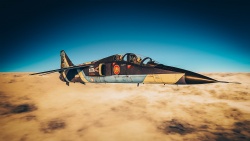
The JM61A1 20 mm Vulcan cannon is a monster and, at the same time, a headache for new pilots not used to it. Unlike most other machine guns and cannons in the game (or in real life, for that matter), trigger depression here does not immediately produce flying bullets. Due to the characteristics of the JM61A1 cannon, it requires an initial spool-up time or spin of the cannon barrels before ammunition can be fired. The high rate of fire can easily melt the barrel, however with the rotating barrels, each barrel can cool off enough before it is its turn again to prevent damage. To initiate this, trigger depression will result in a .25 second delay before the ammunition begins to fire to allow for the barrels to get to proper rotating speed. Once it gets going, 750 rounds of ammunition do not last very long.
When targeting an aircraft, for example, the pilot must remember this formula to be successful while leading an aircraft or before an aircraft passes through the crosshairs, start squeezing the trigger about .5 to .25 seconds before that event, and the cannon rounds should land on target. Waiting until a target passes through the crosshairs (unless tailing them) will result in a miss as they will be out of the sights before the cannon starts firing.
Trigger discipline is necessary when using this cannon as due to its rate of fire (about 6,000 RPM, ~100 RPS or 7.5 seconds of ammunition) will easily blow through the 750 rounds carried by the T-2 Early.
Suspended armament
The T-2 Early can be outfitted with the following ordnance presets:
- Without load
- 2 x AIM-9E Sidewinder missiles
- 5 x 500 lb LDGP Mk 82 bombs (2,500 lb total)
- 5 x 750 lb JM117 cone 45 bombs (3,750 lb total)
- 76 x FFAR Mighty Mouse rockets
- 16 x Zuni Mk32 Mod 0 ATAP rockets
- 2 x AIM-9E Sidewinder missiles + 5 x 500 lb LDGP Mk 82 bombs (2,500 lb total)
- 2 x AIM-9E Sidewinder missiles + 5 x 750 lb JM117 cone 45 bombs (3,750 lb total)
- 2 x AIM-9E Sidewinder missiles + 76 x FFAR Mighty Mouse rockets
- 2 x AIM-9E Sidewinder missiles + 16 x Zuni Mk32 Mod 0 ATAP rockets
Custom loadout options
| 1 | 2 | 3 | 4 | 5 | 6 | 7 | ||
|---|---|---|---|---|---|---|---|---|
| 500 lb LDGP Mk 82 bombs | 1 | 1 | 1 | 1 | 1 | |||
| 750 lb JM117 cone 45 bombs | 1 | 1 | 1 | 1 | 1 | |||
| FFAR Mighty Mouse rockets | 19 | 19 | 19 | 19 | ||||
| Zuni Mk32 Mod 0 ATAP rockets | 4 | 4 | 4 | 4 | ||||
| AIM-9B Sidewinder missiles | 1 | 1 | ||||||
| AIM-9E Sidewinder missiles | 1 | 1 |
Usage in battles
This aircraft doesn't have any countermeasures (like flares, RWR). Any aircraft with air-to-air missiles will pose a threat to you. Although you can use rockets instead of flares, their effect is very limited. Moreover, the T-2 has no IRST system. Any plane with SARH missiles will pose a threat to you (F-4C, MiG-21, F-8E). Unless you see the other side firing missiles at you, you will not be able to detect the launch before being hit. Offensively, the damage caused by the JM61A1 gun is seriously insufficient. The gun's shooting axis is off centre, near the lower left position.
Pros and cons
Pros:
- Faster and better acceleration than many jets at its BR
- High climb rate
- 2 pilots (not as vulnerable to pilot snipes)
- Devastating JM61A1 rotary cannon with a decent ammo pool
- Variety of air-to-ground and multirole payloads
- Decent PD radar that can detect up to 60 km away, useful in large maps to find targets
- The high Angle-of-Attack in certain maneuvers can be very useful defensively and offensively
- Very fast in it's BR
Cons:
- A lack of any Countermeasures make it an easy kill in its BR, where air-to-air missiles are common
- Poor energy retention, low-speed manoeuvrability and large turning radius make avoiding missiles and dogfighting extremely challenging if often impossible
- A lack of Ballistic Computer limits the use of the air-to-ground munitions
- The JM61A1 rotary cannon may take getting used to as it doesn't fire immediately but has a short spool up time before it starts firing
- Burns through fuel at an astronomical rate
- Mediocre AIM-9E missile
- Both engines overheat at constant use with the afterburner
- Lacks RWR receiver (however radar missiles are easy to notch at it's BR
History
Describe the history of the creation and combat usage of the aircraft in more detail than in the introduction. If the historical reference turns out to be too long, take it to a separate article, taking a link to the article about the vehicle and adding a block "/History" (example: https://wiki.warthunder.com/(Vehicle-name)/History) and add a link to it here using the main template. Be sure to reference text and sources by using <ref></ref>, as well as adding them at the end of the article with <references />. This section may also include the vehicle's dev blog entry (if applicable) and the in-game encyclopedia description (under === In-game description ===, also if applicable).
Media
- Skins
See also
External links
| Japan jet aircraft | |
|---|---|
| IJNAS | |
| Experimental | Kikka |
| Reconnaissance | R2Y2 Kai V1 · R2Y2 Kai V2 · R2Y2 Kai V3 |
| IJAAS | |
| Fighters | Ki-200 |
| JASDF | |
| Fighters | F-86F-30 ▅ · F-86F-40 ▅ · F-86F-40 JASDF▅ |
| F-104J | |
| F-4EJ Phantom II · F-4EJ ADTW · F-4EJ Kai Phantom II | |
| F-15J · F-15J(M) | |
| F-16AJ | |
| F-1 | |
| Trainers | T-2 Early · T-2 |
| Foreign | |
| Thailand | ▄AV-8S · ▄F-5E FCU |
| Japan premium aircraft | |
|---|---|
| Fighters | Hagiri's A5M4 · A7He1 · Ki-27 otsu Tachiarai |
| Ki-44-II otsu · ▅Bf 109 E-7 · ▅F4U-1A · Ki-100-II · Ki-44-I 34 | |
| ▅Fw 190 A-5 · A7M1 (NK9H) · Tada's Ki-61-I hei · ▅P-51C-11-NT | |
| J2M4 Kai · A6M5 Ko · A6M6c · J2M5 · Ki-87 · J6K1 | |
| Twin-engine fighters | Ki-96 |
| Jet fighters | F-86F-40 JASDF▅ · T-2 Early · F-4EJ ADTW |
| Strike aircraft | ▄AV-8S |
| Bombers | Ki-21-I hei · Ki-48-II otsu · H8K3 · B7A2 (Homare 23) · ▅B-17E |


